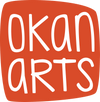Okan Arts Quilting & Textile Tours to Japan are open for booking. To learn more +click here
by Patricia Belyea
TOKYO JP Three very special people actualized my dream of visiting a chusen-dyeing factory in Japan.
Artist Sanae Naito, a university lecturer and creator of her own chusen-dyed textiles, arranged the tour. Mr Toyoda, a collector of Japanese arts and crafts, joined us. And Mr Abe, the factory owner, welcomed us to his family business at the north end of Tokyo.

Mr Abe explained that his factory specializes in dyeing tenugui as there is currently little demand for hand-dyed yukata cottons.
We took off our shoes and donned provided slippers before we stepped into the factory. The entry area was filled with cottons, stretched into rolls and ready for dyeing.

First we watched resist paste being applied to the narrow-width cottons. Artisans rolled one meter lengths of cotton across their work tables, pulled down the lacey-cut stencils, and swept blades of resist paste across the patterns. This step was repeated 24 times to prepare each 24-meter tanmono (bolt) for dyeing.

A huge vat of resist paste perched beside each artisan. By the end of the day, two-thirds of the paste was used up.

The piles of prepped fabric were wrapped with sute-nuno (old cloths), placed on the floor, and covered with sawdust to protect the resist paste. Watch your step!

Dyeing artisans placed the folded fabric on vacuum tables, tucking the edges under heavy lengths of black rubber. To keep the colors separate, they made dams around the different dye areas. When pouring the dyes, the artisans activated vacuum compressors with foot pedals. The strong suction pulled the dyes through all the layers.
Dyed from the top, the piles were flipped over and dyed from the other side—permeating the fabric with color.

The artisans easily filled the long-spouted dye pots by scooping them into buckets of vibrant liquid color.

Mr Abe’s son poured dyes with both hands. He looked so graceful as he waved the flowing pots of dye across the table while pressing the foot pedal in synch with his actions.

Once the dye colors oxidized, the yardage was vigorously washed to remove resist paste and any extra dyes.

After four wash cycles, the fabric was spun in an extractor until lightly damp.

To finish drying, the long lengths of fabric were hung outside in the sun. This sight made my heart soar.

We tromped upstairs to a barn-like room with clotheslines stretched down its length. On rainy days or when the factory works through the night, the dyed fabric is hung here to dry. Or it’s fed through a mammoth iron that dries four bolts of cloth at one time.

Stacks of stencils filled one end of the room, organized by customer.
Historically the stencils were made of “bitter paper”—washi paper painted with bitter persimmon juice and smoked until waterproof. To hold the pattern pieces together, silk gossamer was laminated across the stencil.
These days the stencils are made with “chemical” paper and “chemical” threads, explained Sanae.

From upstairs we got a great view of the nearby river. Originally the factory had washed out its fabrics in the river. Today Mr Abe oversees wastewater holding tanks to ensure that his factory does not pollute the environment.

Back to the gorgeous fabrics. To finish, the fabric is wound on a roller to remove wrinkles, and folded back and forth to the tenugui length (90cm). Then it’s shipped to Mr Abe’s customers.

In a cab back to the train station, Sanae told me that Mr Toyoda has one million pieces of tenugui in his collection. Although Mr Toyoda doesn't speak English, he nodded his head affirmatively when I exclaimed “A thousand, thousand tenugui!”

Mr Abe had given each of us a tenugui he designed himself when we departed. For the Year of the Monkey, his tenugui was decorated with expressive red monkeys.
So now Mr Toyoda has one million and one tenugui! And I’ve finally visited a chusen-dyeing factory!
# # # # #
ABOUT US: Okan Arts, a petite family business, is co-owned by mother-daughter duo Patricia Belyea and Victoria Stone. Patricia and Victoria sell Japanese textiles online, host creative quilting experiences, and lead quilting & textile tours to Japan.
FOLLOW OKAN ARTS ON INSTAGRAM @okanarts









